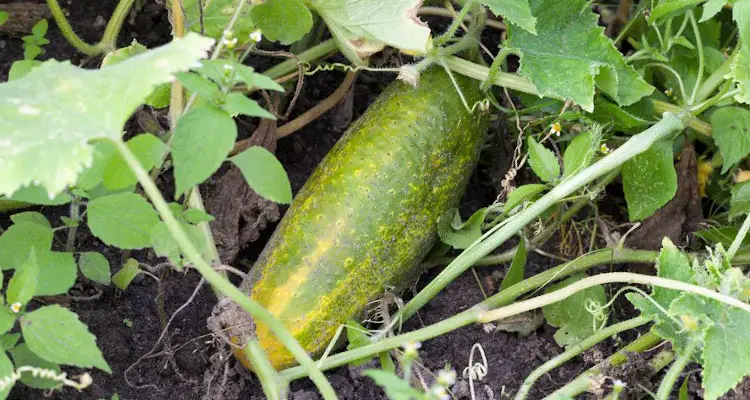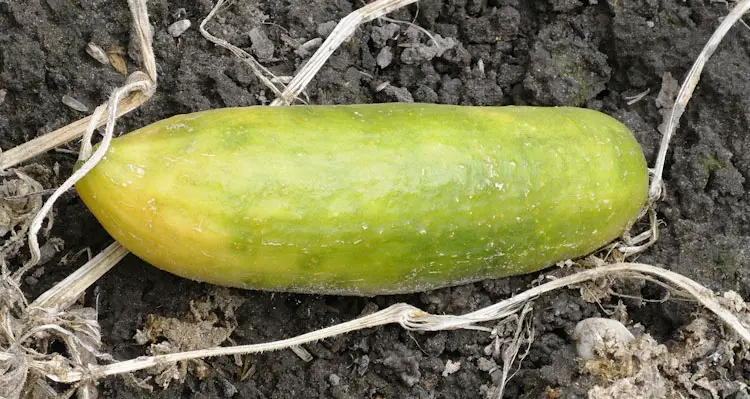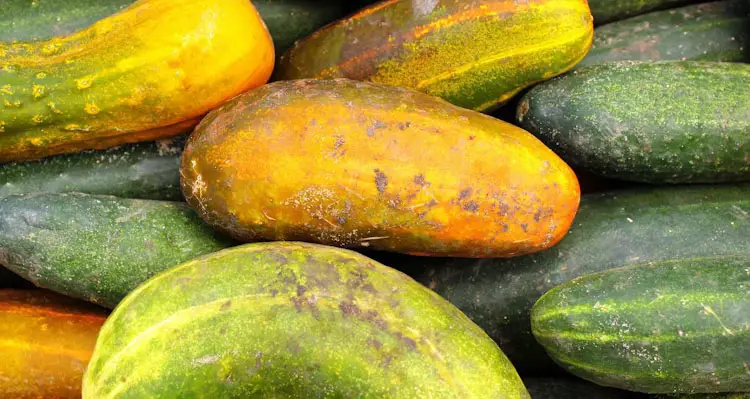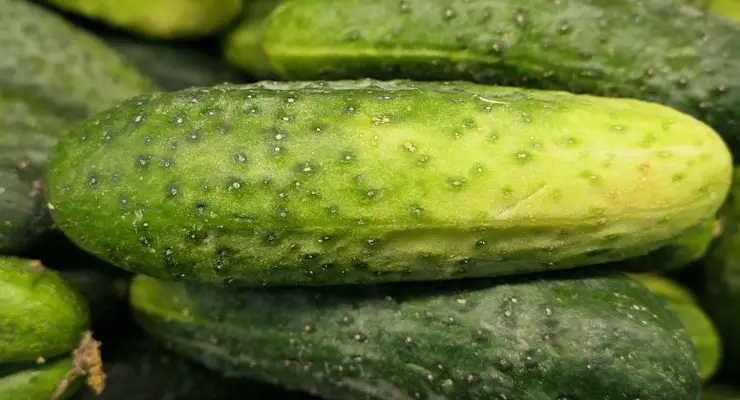Last year, my cousin came to me in a bit of a panic, trying to find out why her cucumbers were turning yellow.
Since she had no information on variety, planting time, or the like, we had to look at some usual causes.
Besides the unique yellow varieties, most cucumbers become yellow as they ripen or as a sign of disease, insufficient water, or nutrients.

Have you noticed that your cucumbers look yellow and rough around the edges? Then this article is definitely for you.
In this post, you will learn the 4 main reasons why cucumbers turn yellow and possible solutions. Let’s get started.
1. Late Harvesting
Like all plants, cucumbers have their own lifecycle. As they go through this process, they can change colors at different stages of maturity.
For instance, you might notice that their usual green skin has started to fade, turning yellow or orange if you wait too long before harvesting them.

You’ll also limit how many cucumbers your plant produces by picking them at this mature stage. In contrast, regular harvesting of immature fruit encourages growth, which means bigger yields for you and your family.
There are several varieties of cucumbers, but most will be ready to harvest within 50-70 days of planting. So ensure you make a note of the sowing date.
Also, be on the lookout for female flowers. Cucumbers are typically ready to harvest about 8 to 10 days after these flowers emerge. For more information, please read our article, which explains the best time to harvest cucumbers.
2. Lack Of Water
Cucumbers reportedly contain about 95% water. So it should be no surprise that a lack of water can adversely affect its growth, color, and other characteristics.
They also have shallow roots, which tend to dry out easily if you do not water them consistently. This results in abnormal growth of the plant and its fruits.
Cucumbers thrive in moist, well-drained soils. You can achieve this balance by regularly watering and adding organic mulch, or extra compost, to assist with soil structure and water retention.
3. Not Enough Nutrition
Cucumbers are fast-growing, heavy feeders. And like most plants, they need the perfect combination of nutrients to grow healthy. Not surprisingly, this was the reason for my cousin’s woes.
They’re more likely to turn yellow or experience stunted growth if you haven’t fertilized your cucumbers enough. These are tell-tale signs that something has gone wrong in the growing process.

To ensure your cucumbers get the right amount of nutrients, consider adding fertilized compost into your soil when you plant them.
Once your cucumbers have bloomed, we’d recommend fertilizing them again with an organic liquid fertilizer roughly once every other week.
Also, the soil will eventually deplete nutrients if you’re growing your cucumber in the same spot, year after year. So, ensure you switch locations or amend the ground with the nutrients and organic matter.
Note: Take a look at our article about The Nutritive Cycle Theory for suggestions on natural homemade fertilizers to use at different stages of the plant's development.
4. Bacterial Wilt
If you notice yellow leaves full of holes and weak, wilting stems, there’s a good chance that the cucumber beetle has come to feast on your vines.
These visible issues are the least of your worries since Cucumber beetles can also spread bacterial diseases, which can be detrimental to your plants.
So, how do you know if bacterial wilt is the culprit? Take a small trimming from a wilting stem and gently tease it open. You’re looking at bacterial wilt if you can see thin, thread-like strands inside the vine.
Unfortunately, the plant will need to be removed to prevent the infection from spreading further. If not, it can significantly damage your cucumbers within just a few days.
To prevent bacterial wilt from targeting your cucumbers, you must stop the cucumber beetle from gaining access to your veggies.
Note: You can use various methods, such as row covers, traps, and even organic pesticides, to control cucumber beetles. However, remember that these infestations are usually seasonal, and plan accordingly.
Can You Eat Yellow Cucumbers?
Now that you know some of the most common causes of yellow cucumbers, you may want to see if you can eat them.
In short, you can eat yellow cucumbers, provided they are firm and don’t show signs of damage, rot, or other blemishes. However, we would not recommend eating them unless they are yellow varieties or you enjoy bitter foods.

Don’t worry. We won’t judge you if you don’t like the taste. We don’t either. You can throw the unused cucumbers into your compost heap since they are rich in nitrogen. The only downside is that you might have tons of unwanted seedlings.
Final Thoughts
Although the sight of yellow cucumbers might be alarming, our first advice is to stay calm!
There are many reasons your cucumbers may turn yellow, but not all of them mean they have passed the point of no return.
Use our tips above to assess the damage, find the cause, and find possible solutions to your yellowing cucumbers.
References
University Of Delaware. Yellowing Cucumbers. sites.udel.edu/weeklycropupdate. Accessed November 2022
University Of Minnesota Extension. Discolored Cucumber Leaves. apps.extension.umn.edu. Accessed November 2022

